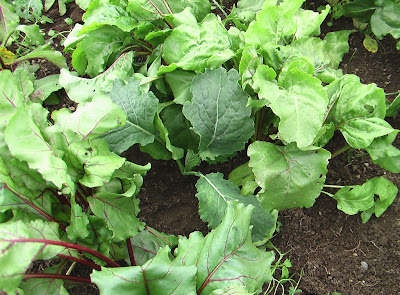
We harvested some beets this week, from both of the varieties. Both the roots and the leaves will be eaten. In the space between the two rows of beets we transplanted from bed DD6:
- Vertus Savoy Cabbage (5 plants at the north end) - medium late variety with round flattish heads, medium green, well curled and frost hardy
- Cour di Bue Summer Cabbage (3 plants at the south end) - large pointed heart variety, maturing in early autumn, light green in colour
Although the plants are crowded at the moment, next week we will be harvesting the beetroot from around the cabbage transplants, and within a month or so, all of the beets will be harvested from both rows, leaving plenty of space for the cabbage plants to grow to maturity.
We could have waited for more of the beetroot to be harvested before transplanting, but the brassica seedbed is getting really crowded, and by planting in among the beetroot, the plants will gradually get more space, which will be a smoother transition than going from a crowded bed to being transplanted into an open wind swept bed.
 The Extensive Plot is fully cultivated and all of the cool tolerant plants are thriving, while the warm season courgettes, beans and sweetcorn are struggling.
The Extensive Plot is fully cultivated and all of the cool tolerant plants are thriving, while the warm season courgettes, beans and sweetcorn are struggling. Only one more bed to Double-Dig!
Only one more bed to Double-Dig! The Polycrop Plot still has 2 beds that need to be cultivated and planted.
The Polycrop Plot still has 2 beds that need to be cultivated and planted.
















































